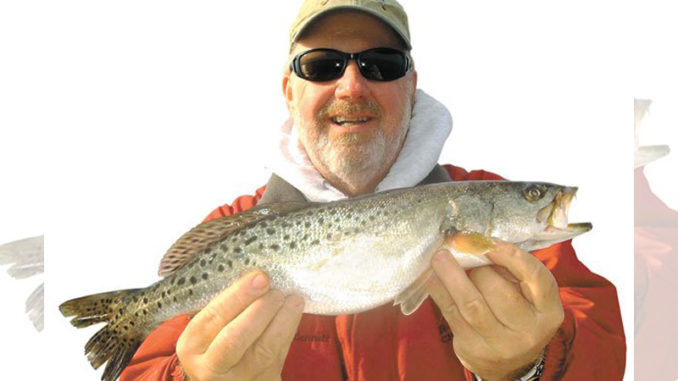
Easy access and productivity make this destination among North Carolina’s most popular.
Wrightsville Beach is a coastal destination many fishermen are aware of, even if they have never visited or fished there; the latter would be a bit of a surprise.
Wrightsville Beach is the easiest beach to access from all across North Carolina, as simple as following I-40 east and turning left at the second traffic light beyond the interstate’s eastern terminus. The intersection will be US 74, and it ends is a few miles away near Johnnie Mercer’s Pier in Wrightsville Beach.
Most fishermen envision the Atlantic Ocean and Intracoastal Waterway when thinking of Wrightsville Beach, as they are its eastern and western boundaries. Through Shinn Creek, Masonboro Inlet is the highway to the ocean and is one of only a few North Carolina inlets that is jettied on both sides to maintain stability.
Mason’s Inlet is to the north, but it is not navigable. Howe Creek, Pages Creek, Futch Creek and Middle Sound are also to north of Wrightsville Beach, and provide they numerous fishing opportunities. Bradley Creek, Shinn Creek, Hewletts Creek, Whiskey Creek and Masonboro Sound lie to the south and also provide numerous fishing opportunities.
These waters are relatively clean
The inshore waters around Wrightsville Beach are some of the cleanest along the Tarheel State’s coastline. Wrightsville Beach is miles above Frying Pan Shoals and the effluence-laden waters of the Cape Fear River, while also being miles below the New River. The inlets in the area are not part of a river system. But they feed and drain the coastal estuaries and do not become murky as the rivers do. Sight-fishing is a combination of seeing fish in the water and seeing fish moving in the water, and many of the backwater areas around Wrightsville Beach provide both opportunities.
Anglers access the waters around Wrightsville Beach through a myriad of private and neighborhood ramps and a pair of free public ramps. The largest is an N.C. Wildlife Resources Commission ramp immediately on the north side of the US 74/76 bridge crossing the ICW. Another recently renovated ramp that is more suited for smaller boats, canoes and kayaks is the New Hanover County Trails End Ramp at the end of Trails End Rd. on the mainland at Masonboro Sound and Whiskey Creek.
“Rod-Man” Bennett was lured here many years ago
Even as a youngster, Capt. Rick “Rod-Man” Bennett envisioned the coast as the place he wanted to be. Born in Greensboro and raised in Burlington, his addiction to the coast and saltwater fishing began with childhood family trips and became more consuming as he grew older. During college and early in his first career, banking, he travelled to the coast almost every weekend. He still laughs when he admits all his job relocations were moves to the east and purposely closer to the coast.
Finally, in 1987, Bennett relocated to Wilmington as senior vice president of a local savings and loan that thrived. But when it was sold in 1996, Bennett found himself in Wilmington without a job. He began building custom rods in 1984 and was fishing at every opportunity. So he decided it was time to combine his love of rod-building with his love of fishing. The Rod-Man expanded to include Rod-Man Charters. He has never looked back.
1. Masonboro Inlet North Jetty
34.10.75N/077.48.21W
“The jetties here are almost like different places to fish, so I’m going to treat them like that,” Bennett said. “The north jetty has a little bit of many kinds of fish. During the course of the year, there are red drum, flounder, trout, black drum, bluefish, Spanish mackerel, king mackerel, bonito and more. Two of the larger and more interesting fish that visit the jetty are cobia and tarpon.”
Bennett said the first activity begins in March with bluefish, which may stay as late as December. Black drum and red drum arrive just a bit later and stay well into the fall. Bonito are April visitors and are often found in the tideline trailing off the jetty. Spanish mackerel follow in later April and early May and stay until October, with scattered kings a possibility once the water warms into the 70s. Bennett said bonito, bluefish and Spanish mackerel respond well to lures, while drum often prefer bait.
Cobia gather around the mouth of the inlet in May and June and can be caught with dead baits fished on the bottom, live baits suspended under floats and occasionally with jigs. Bennett said tarpon wait for the warmest water of the year and often mill around the jetty during June on their way up the coast and again in August and September as they move back south. They feed similarly to cobia and are occasional surprises to cobia fishermen during June and to king mackerel and Spanish mackerel fishermen in the fall.
2. Masonboro Inlet South Jetty
34.10.64N/077.48.37W
“The south jetty is unique, as it has a sort of whirlpool on the offshore end during an incoming tide,” Bennett said. “This spinning water disorients and traps some baitfish and attracts predators. Trout are one of the favorites, with red drum being secondary. There are also some black drum and bluefish, but they are mainly caught incidental to fishing for the others.”
Bennett said the predominant southwest winds of late spring into fall push baitfish up against the outside of the south jetty. Trout fishermen regularly work along the edge and cast into all the pockets where bait can hide. He said fishermen here use a variety of live baits, with shrimp being a favorite — but also a favorite of all the smaller bait thieves. Soft-plastic artificial baits, primarily minnow and shrimp shapes, also work well.
Bennett said red drum might be found here at any time, but his favorite is an outgoing tide. He fishes the inside edge of the jetty and concentrates on fishing slower and deeper.
3. Shinn Creek Bank
34.11.46N/077.49.16W
The channel from Masonboro Inlet to the ICW runs through Shinn Creek. This creek has a deep channel, with strong current, and there are several places the drop-off comes up near the bank and creates a transition zone where the current slows a bit. This spot is one of those.
“All the current through here moves a lot of bait,” Bennett said. “This bank is on the outside edge of a bend in the channel, and bait gets pushed up onto the slope and flat just above it. I think of this as a spot for trout, but there is a mixture of fish that come through on any tide.
“During the spring and fall, you can have a lot of fun here catching bluefish. During the summer and fall, some flounder may be on the transition from the flat to the channel, and enough red and black drum move through that it isn’t a big surprise to catch one at any time.”
Bennett said this is a spot where he fish can react to live minnows, but there are a lot of bait thieves when the water warms, and it often means changing or replacing baits frequently. He said the tide flowing along the drop is usually just about right to bump a soft-plastic or Gulp! bait across the area and cover more ground.
4. Masonboro Sound Drop
34.10.49N/077.49.81W
“This is a trout spot,” Bennett said. “You might occasionally catch a red drum or flounder, but this is a place many fishermen come to catch trout. It also fishes a little different, too. Instead of anchoring out and casting in to it, you anchor close to the grass and cast out.”
Bennett said this particular part of Masonboro Sound connects the ICW and Masonboro Inlet. A big sandbar is on the opposite side and closer to the inlet where many folks gather on warm weekends; as long as the weekends are warm, there is plenty of boat traffic. The trout are more aggressive in cooler water, so the optimum time is late fall, but there are also some trout caught on cooler weekdays earlier in the fall.
Bennett said the bottom in this area is mainly shell, and the drop-off begins about 10 to 15 yards off the bank and continues into the channel — a good, long cast away. The falling tide is a good time to fish here, and artificials usually perform well. He suggests diving MirrOLures, X-Raps and Gulp baits on heavier jig heads to get down to the bottom and let the tide push the bait along so it looks like a baitfish that is trapped in the tide.
5. Point in Hewletts Creek
34.11.03N/077.50.52W
This point in Hewletts Creek has water flow on any tide, plus an oyster rock on the right side that becomes visible at low tide. Bennett said the combination of water moving around the point and being broken up by the oyster rock makes for a great place to fish. You might have to reposition a little for various stages of the tide, but this point holds red drum and flounder on the flats around the oyster rock and trout in the deeper water beside it and out into the channel.
“I primarily fish here using artificials on as light a (jig)head as possible,” Bennett said. “The light head keeps it from falling into all the snags along the oyster rock, and the fish are moving, so we can cover more area to find them. The fish will get right up on the oyster rock to feed, and it is important to work all around it. If you don’t occasionally lose some jigheads and grubs here, you’re not fishing where many of the fish are.”
Bennett said Hewletts Creek begins to warm in the spring and may be a few degrees warmer than surrounding waters for several weeks. The mud banks and shallow cuts back in the creek keep the water warmer later into the fall. There are usually a few fish holding along this point and oyster rock except for the coldest months of the year.
6. ICW Money Dock
34.11.29N/077.49.81W
When asked where his nickname name of this location originated, Bennett paused a second as he scanned the nice dock leading up to a large house and simply said, “I don’t know.” A growing smile gave away his bluff.
“It’s probably because if you fish here through a complete tide, you should catch fish — sort of like money in the bank.”
Bennett said the area holds fish from around Easter through Christmas. He likes to arrive just before high tide and fish the area from the shell bank out to the flooded grass. It’s a good place to catch some redfish, black drum and an occasional flounder.
He also pointed out the large end of the dock and said the shade and protection it offers as attractive to drum and flounder during the heat of the summer. He said there is enough tide to scour little depressions around the pilings, and the fish gather in them while waiting for the tide to push something past.
“This is a place to fish live bait,” Bennett said. “The bottom is clean enough, and there is plenty of bait around. Sometimes, it would be very difficult to get an artificial bait noticed. I use a Carolina rig and cast to the bank or under the dock and creep it back towards me. Peanut pogies and mullet minnows are my favorite baits. They are a little larger, and the numerous bait thieves don’t seem to bother them as much as shrimp or mud minnows.”
7. Bradley Creek Bridge Hole
34.12.91N/077.50.03W
“While it takes a while to idle up the creek past the marinas and all the docks, this is usually a place that will give up some drum,” Bennett said. “Both red drum and black drum live in this creek, and a few always find their way into this hole when the tide gets low.
“During milder winters, they may be here all year. But when the weather and water is really cold in the winter, they leave when it gets cold and return in the spring. Much of the creek above the bridge falls out to almost dry on low tide. And this is the first deep spot any of those fish reach when moving out. This hole usually has a few fish and sometimes it is loaded.”
Bennett said this is a place he prefers to fish with bait. He uses a mixture of live minnows and shrimp and some pieces of cut shrimp or minnows. Bennett prefers the simplicity of a Carolina rig for fishing with bait.
8. Wrightsville Beach Drawbridge
34.13.11N/077.48.74W
Bennett said that as busy as the ICW is in Wrightsville Beach, there are often a few flounder holding along its edge and in a little pocket on the north side of the bridge between the mainland bank and the bulkhead. He said this is a spot he considers a weekday spot, as there was a lot of traffic in the ICW on weekends.
A pocket beside the bridge also provides a cobia hookup or two each year. Bennett is hesitant to call it a spot to catch cobia, but there has become a consistent-enough pattern that a few people had begun to try. The two problems are that the time — late May to mid-June — when cobia might be there is short, and there are so many pilings, the bridge bulkhead and ICW traffic that the odds of landing one are stacked pretty well against the fisherman.
“I like to ease into position and fish live peanut pogies or finger mullet, Bennett said. “When the tide is falling, I let them slowly drift back under the bridge into the shadows. The flounder bite is pretty subtle, but if you have a cobia grab your bait, you know pretty quickly. The first flounder might arrive in late April to early May, but they grow all summer and are the largest and most aggressive in the fall.”
9. Statue of Liberty Dock in ‘Lollipop’
34.13.49N/077.47.12W
“The ‘lollipop’ is simply a pretty big bay that runs off of the (ICW) just north of the Wrightsville Beach Bridge,” Bennett said. “It is a fishing destination, because the only water flow is tidal, and it holds bait. It will warm a little earlier in the spring and stay warm longer into the fall. The name comes in that it looks like a lollipop. The channel from the (ICW) is the “stick” and the bay is the “lollipop.” Everyone knows it by that name and always has.”
Bennett said numerous places in the lollipop sometimes hold fish. There are obviously many docks, plus a few oyster bars and some grass edges both in the lollipop and along the channel leading to it. Sometimes, he said, several boats might be fishing there at the same time. And often, they are all concentrating on different things.
“I like to concentrate on the dock with the Statue of Liberty,” Bennett said. “My clients seem to like the idea, and almost all take a picture. But better than that, we usually catch some fish around it. Some red drum hang around the pilings and up along the bulkhead. Occasionally, a flounder is in there during the warm months. And some trout hold in the deeper water off the end during the cool months.”
Bennett said the general area of the lollipop is fished pretty often. So he plans on using live bait when he goes there. He said peanut menhaden and finger mullet are his favorites because. The bait thieves don’t beat them up as badly.
10. Motts Channel Grass Point
34.12.83N/077.48.54W
This little point is passed by and overlooked by hundreds, maybe even thousands of fishermen each year, according to Bennett. Motts Channel is pretty busy. And this is one of only a few places in it where marsh grass grows down to the water’s edge. Some docks sit just to the east and west, and they seem to serve as the boundaries for the good fishing.
“With the tide up, you can’t see the oyster rock at this point,” Bennett said. “It sets up a little more out into the creek and rolls off into deeper water in that little corner on the east side. The oyster rock attracts red drum, and that drop on the edge around the corner usually holds a few flounder. It can be a little hard to fish at times. But it’s usually worth the effort.”
Bennett said this is a late-spring to late-fall spot. He usually fishes here with live bait, either a mullet minnow or peanut menhaden, on a Carolina rig. Positioning the boat to fish along the oyster rock and not staying hung up are two big factors in catching fish. Bennett said he also occasionally catches black drum and wouldn’t be surprised what might bite with smaller pieces of shrimp or cut bait.
Capt. Rick Bennett can be contacted at www.rod-man.com or 910-520-7661.

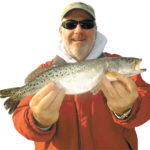
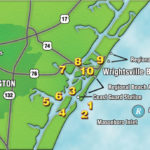
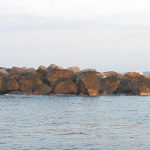
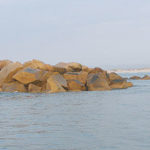
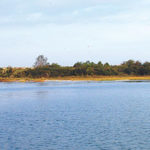
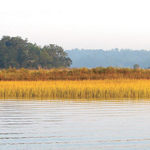
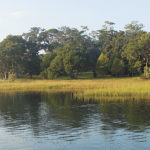
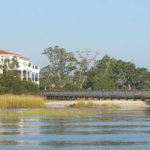
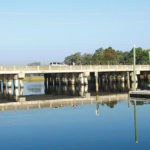
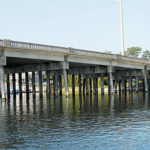
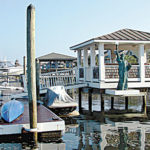
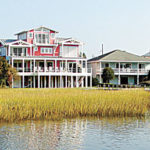



Be the first to comment